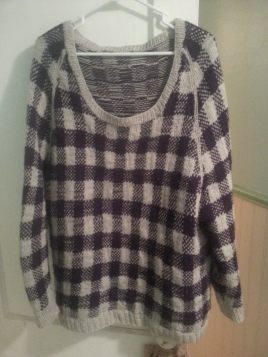
There it is in all of its over-sized glory!
Alternatively this should be titled Why Gauge Sometimes Really Matters.
…But you know, nobody has time for that. (Also, in my case, why checking your needle size also super matters. )
When I first saw this pattern floating around Tumblr I was compelled to knit it. My knitting sense was tingling.
By this point in my knitting career I had grown pretty tired of working on basics–scarves, fingerless gloves, hats–I was desperate for a new challenge. Earlier in the year I tackled the Endpaper mitts (also with the wrong size needles, can we sense a pattern yet?) and I realized that even though fair isle knitting looks ridiculously complicated, it’s actually not that hard to do. I had been playing it safe with my knitting. It was time to do something adventurous, exciting, and maybe just a little bit crazy. Okay maybe not that dramatic. But it was time to achieve the crowning glory of my knitting endeavors–my very own hand knit sweater. And I chose this glorious pullover to be my introduction to sweater crafting. *cue gross sobbing*
Pro tip: For the love of all that is good in the universe knit a gauge swatch…or at least have a really good idea of your measurements before you start. I did neither, and then proceeded to knit the sweater with needles a size larger than the pattern calls for because I actually thought I had the correct size needles resulting in a garment that is almost 2 sizes too big for me and fits strangely in my shoulders. But as I frequently say with a lot of my projects, live and learn.
So being new to this whole sweater making business, and now with two sweaters under my belt, I have to say that I really dislike raglan construction. I know that it exists so that you can knit everything on circular needles with minimal seaming, but I find that it does not lend itself to garment shaping very well. Either that or I am doing it wrong. It’s possible it is a combination of both.
This sweater was made more complicated by the fact that on top of the raglan decreases you had to maintain the check pattern, and there aren’t really any notes in the pattern as to how you are best supposed to do this. So I just made the call to knit all of my decreases with my gray color. The only other bit that I was frustrated with about the pattern is that the pattern maker chose to knit both of her sleeves at the same time and then steek them. (More on steeking at a later date). This form of construction is fine, but since I didn’t have a second set of circular needles I was stuck knitting each sleeve one at a time on double pointed needles (DPNs). I don’t mind DPNs but it left me unsure how to do the sleeve increases properly. I wish there had been some notes included about that.
Overall, I enjoyed working this pattern despite the snafus I encountered throughout the knitting process. You will come to find that I consider the best patterns are the ones that result in what looks like a complex pattern, but is actually quite simple to achieve.
 In this case, the blocks of alternating colors adjacent to the solid blocks of colors easily result in a plaid-like effect throughout the entire garment.
In this case, the blocks of alternating colors adjacent to the solid blocks of colors easily result in a plaid-like effect throughout the entire garment.

So simple and yet so brilliant. If you are new to colorwork/stranded/fair isle knitting, the floats (or the working yarn you carry across several stitches) may seem long, but wrapping or easing up on your typical knitting tension should alleviate your worries. I don’t usually wrap when I do color work because I am lazy, and luckily I knit loosely enough that I have yet to experience puckering in my finished projects.
Needless to say I’m proud that my first sweater, while not perfect, was a bit more complicated than just straight stockinette (god I hate endless rows of stockinette). I have several patterns for sweaters queued that utilize different types of construction so I am curious to see which one I end up liking the best.
XOXO
Notes: Yarn used for this project is from Knit Picks Palette Line in Finley Heather and Indigo Heather.
 I actually really like these puppies. They are from this sock pattern here. This is definitely one of my favorite motifs (though still not my absolute favorite one). I actually need to go back to working on this project, but I’m trying to wrap up some of my larger projects first.
I actually really like these puppies. They are from this sock pattern here. This is definitely one of my favorite motifs (though still not my absolute favorite one). I actually need to go back to working on this project, but I’m trying to wrap up some of my larger projects first.


